Tiridates I of Armenia › The Kingdom of Kush › Arsacid Dynasty of Armenia » Origins and History
Articles and Definitions › Contents
- Tiridates I of Armenia › Who Was
- The Kingdom of Kush › Origins
- Arsacid Dynasty of Armenia › Origins
Ancient civilizations › Historical places, and their characters
Tiridates I of Armenia › Who Was
Definition and Origins
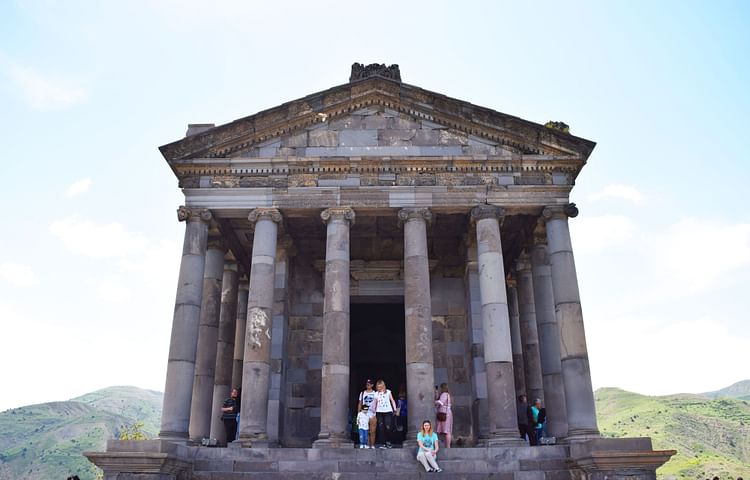
Tiridates I (Trdat I) ruled as the king of Armenia from 63 to either 75 or 88 CE). Considered the founder of the Arsacid dynasty proper, his reign got off to a rocky start with invasions from Rome and Parthia but, once crowned in a lavish ceremony in Rome conducted by Nero himself, the Armenian king would rule for a relatively peaceful and highly prosperous two decades.When exactly his reign ended is disputed due to conflicting ancient sources, but he was (probably) succeeded by his son Sanatruk II who continued with his father's success in balancing Armenia on the diplomatic tightrope it seemed destined to forever occupy between the region's two superpowers.
SUCCESSION
Tiridates I of Armenia was the brother of the Parthian king Vologases I (aka Vagharsh, rc 51- up to 80 CE, dates disputed) who invaded Armenia in 52 CE for the specific purpose of setting Tiridates on the throne. The Roman Empire was not, though, content to passively permit Parthia into what they considered a buffer zone between the two great powers. Further, an embassy arrived in Rome which represented the pro- Roman faction in Armenia and they asked for direct assistance.Consequently, Roman emperor Nero (r. 54-68 CE) sent an army under his best general Gnaeus Domitius Corbulo in 54 CE to restore Roman influence in the region.
TIRIDATES WAS SUPPORTED BY MOST OF THE ARMENIAN PEOPLE WHO WERE MORE SYMPATHETIC TO PARTHIA THAN TO ROME FOR HISTORICAL & CULTURAL REASONS.
First, Corbulo was given the task of securing both Syria and the small kingdom of Sophene (Dsopk) to beef up Rome's presence in the region and remind Parthia who they were up against. Then, when Parthia declared Armenia a vassal state in 58 CE, Corbulo moved northwards and attacked Armenia itself. By the time the Romans arrived in Tiridates' kingdom, Vologases had been forced to withdraw to deal with internal troubles in Parthia but Tiridates remained at the Armenian capital of Artaxata (Artashat). Tiridates was actually supported by most of the Armenian people who were more sympathetic to Parthia than to Rome for historical and cultural reasons.
Corbulo proved again to be a very capable field commander and with logistical support from Roman ships on the Black Sea, he took and destroyed the two most important cites - Artaxata and Tigranocerta. By 60 CE he could claim to rule over all of the kingdom of Armenia and Tiridates was forced to flee back to his brother in Parthia. In the same year, Tigranes V, who had impressive royal connections being the grandson of Herod the Great, was set on the throne as a pro-Roman monarch, but he would only last until the Parthians sent an army to besiege him in what was left of Tigranocerta. Thereafter, Tigranes disappears from the pages of history after the briefest of cameo appearances in the Armenian king lists.
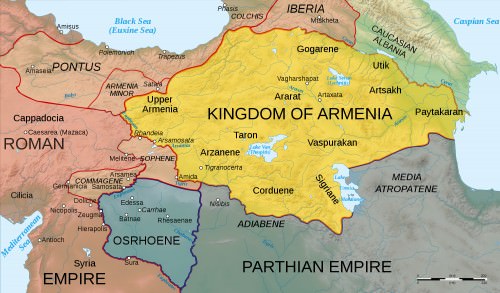
Map of Armenia, 50 CE
In 62 CE Parthia won victory against a Roman army (significantly, perhaps, no longer commanded by Corbulo), but in 63 CE the Romans and Corbulo returned and their threat was sufficient for the Treaty of Rhandia to be drawn up (named after the site in western Armenia). It was now agreed that Parthia had the right to nominate Armenian kings, Rome the right to crown them, and both powers would rule equally over Armenia with the king as their representative. Nero was thus given the privilege of crowning Tiridates in Rome in a lavish spectacle that did much to show the power and global reach of the Roman Empire.
THE CORONATION OF TIRIDATES
In 66 CE, then, Tiridates symbolically presented his crown to an effigy of Nero and then travelled to the great city of Rome to receive it back again from the hands of the emperor. Taking a land route, an impressive entourage, which included the soon-to-be king's wife (wearing a golden helmet and face mask instead of a veil), his children, extended family and 3,000 courtiers, nobles, priests and bodyguards from Armenia, Parthia and Rome, plodded westwards. When Nero had offered to meet the travel expenses he had perhaps not imagined quite such a guest list. It was no surprise either that when the whole troupe arrived in Naples after nine months on the road, they were late. A round of gladiator and athletic games opened the festivities before the actual coronation in the Forum of Rome. There, kneeling before the emperor, Tiridates had to recite what would become the familiar eastern formula of submission:
Master…I have come to thee, my god, to worship thee as I do Mithras. The destiny thou spinnest for me shall be mine, for thou art my Fortune and my Fate. (Payaslian, 29)
Nero replied:
You have done well by coming here to enjoy my presence in person. What your father has not left to you and what your brothers did not preserve for you, I do accord to you, and I make you King of Armenia, so that you, as well as they, may know that I have the power to take away and to grant kingdoms. (Kurkjian, 78)

Roman Emperor Nero
The king was then crowned and allowed to sit on a throne next to Nero, albeit a slightly lower one than the Roman emperor's.The celebrations then continued in the Theatre of Pompey which Nero, true to form, had decked out completely in glittering gold and Tyrian purple canopies as a flamboyant imperial bonus. The Romans loved a spectacle and Tiridates' coronation certainly gave them one; indeed, thereafter, the day of the celebration carried the epithet “golden”. When the party was over Nero gave Tiridates a parting gift of 2 million sesterces and sent him on his way to rebuild Armenia.
A PROSPEROUS REIGN
With such a flurry of ancient sources gushing over Tiridates' coronation, it is rather disappointing that we know so little of the rest of his reign. We do know that the Romans next placed a handful of garrisons in the area to ensure the Treaty of Rhandia was adhered to but generally, there was, as planned by all three sides, a sustained period of peace.
AN INSCRIPTION FROM GARNI REVEALS THAT TIRIDATES WAS NOW CALLING HIMSELF “THE SUN” & “SUPREME RULER OF ARMENIA”.
The kingdom's prosperity, based on natural resources, agriculture and trade permitted Tiridates to build a new summer residence at Garni. A magnificent fortified complex built from white limestone, it boasted all the amenities of any palace anywhere in the Classical world. There were Roman baths, gardens, courtyards, mosaic -floored rooms and even a full-scale Roman temple for the king when in residence (which still stands today). An inscription from Garni reveals that Tiridates was now calling himself “the Sun” and “Supreme Ruler of Armenia”. Other notable projects of the period included the rebuilding of Artaxata after its destruction by Corbulo and which Roman writers record was renamed Neronia in honour of the king's great benefactor. A temple north of that city was dedicated to the god Tir. Finally, a number of estates were set aside by the king for pilgrims to pay homage to some of his relatives, after all, he was the Sun god Helios now. The agricultural production and consequent tribute from these sites also gave a handy boost to the royal treasury.
Notwithstanding the good times, there would soon be a reminder of Armenia's status as a client kingdom. Roman emperor Vespasian (r. 69-79 CE) made absolutely sure that no more territories in the region would fall to the Parthian ruling dynasty by annexing the kingdoms of Commagene and Lesser Armenia in 72 CE. In the same year (or perhaps the next) the nomadic Alani people temporarily invaded Armenia but Tiridates remained unscathed. There was perhaps also an Armenian invasion of Iberia (modern Georgia) but details are lacking in the now silent historical record.
SUCCESSOR & ARSACID DYNASTY
Tiridates I is considered the founder of the long-ruling Arsacid dynasty (Arshakuni) which would last until 428 CE. The dynasty had actually had its first king in 12 CE with the succession of Vonon (Vonones) but the instability of the Armenian throne and many short-reigning monarchs after Vonon has resulted in some historians taking Tiridates, with his more stable regime and that of his successors, as the true founder of the dynasty. When Tiridates died he was (probably) succeeded by his son Sanatruk II who would rule until 109 CE.
This article was made possible with generous support from the National Association for Armenian Studies and Researchand the Knights of Vartan Fund for Armenian Studies.
The Kingdom of Kush › Origins
Definition and Origins
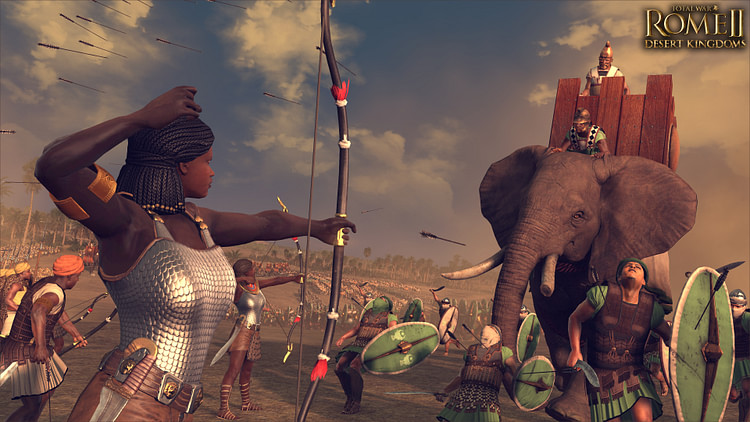
Kush was a kingdom in northern Africa in the region corresponding to modern-day Sudan. The larger region around Kush (later referred to as Nubia) was inhabited c. 8,000 BCE but the Kingdom of Kush rose much later. The Kerma Culture, so named after the city of Kerma in the region, is attested as early as 2500 BCE and archaeological evidence from Sudan and Egypt show that Egyptians and the people of Kush region were in contact from the Early Dynastic Period in Egypt (c. 3150 - c. 2613 BCE) onwards. The later civilization defined as 'Kushite' probably evolved from this earlier culture but was heavily influenced by the Egyptians.
While the history of the overall country is quite ancient, the Kingdom of Kush flourished between c. 1069 BCE and 350 CE.The New Kingdom of Egypt (c. 1570-1069 BCE) was in the final stages of decline c. 1069 BCE, which empowered the Kushite city-state of Napata. The Kushites no longer had to worry about incursions into their territory by Egypt because Egypt now had enough trouble managing itself. They founded the Kingdom of Kush with Napata as its capital, and Kush became the power in the region while Egypt floundered.
Kushite kings became the pharaohs of Egypt's 25th Dynasty and Kushite princesses dominated the political landscape of Thebes in the position of God's Wife of Amun. The Kushite king Kashta (c. 750 BCE) was the first to establish himself on the Egyptian throne and appointed his daughter, Amenirdis I, the first Kushite God's Wife of Amun. He was followed by other great Kushite kings who reigned until the Assyrian invasion of Egypt by Ashurbanipal in 666 BCE.
In c. 590 BCE Napata was sacked by the Egyptian pharaoh Psammeticus II (595-589 BCE) and the capital of Kush was moved to Meroe. The Kingdom of Kush continued on with Meroe as its capital until an invasion by the Aksumites c. 330 CE which destroyed the city and toppled the kingdom. Overuse of the land, however, had already depleted the resources of Kush and the cities would most likely have been abandoned even without the Aksumite invasion. Following this event, Meroe and the dwindling Kingdom of Kush survived another 20 years before its end c. 350 CE.
SPONSORSHIP MESSAGE

NAME
The region was known by the Egyptians as Ta-Sety (“The Land of the Bow”), in reference to skilled Kushite archers, by the time of the Old Kingdom of Egypt (c. 2613-2181 BCE) and the northern area, bordering Egypt, as Wawat. What Kush was called by its inhabitants at this time is unclear; perhaps it was always known as Kush – or some variant thereof – since Egyptian inscriptions also refer to it as Kus, Kas, and Kash. The designation 'Kush' seems to be indigenous while the later name for the same region, Nubia, came most likely from the Egyptians to the north.
The region of Kush was the main source of gold for the Egyptians, and it is thought that 'Nubia' derived from the Egyptian word for gold, 'nub'. There is another theory, however, which claims that 'Nubia' derives from the people known as the Noba or Nuba who settled there. The Egyptians also knew the land as Ta-Nehsy (“Land of the Black People”). Greek and Romanwriters referred to the region as Aethiopia (“Land of the Burnt-Faced Persons”) in reference to the indigenous peoples' black skin, and the Arab tribes knew it as Bilad al-Sudan (“Land of the Blacks”). It should be noted, however, that these designations may or may not have been referencing the whole region.
KERMA & EARLY KUSH
The city of Kerma was established in Kush by c. 2400 BCE and was powerful enough to threaten Egypt as attested by Egyptian inscriptions and forts built to repel raids from the south. Even so, the kings of Kerma and Egypt established a lucrative trade for both parties and Egypt relied on Kerma for the import of gold, ebony, incense, exotic animals, and ivory among other luxury items.
The city centered around a structure known as a deffufa, a fortified religious center created from mud brick and rising to a height of 59 feet (18 meters). Interior passageways and stairs led to an altar on the flat roof where ceremonies were held but what these services entailed is unknown. The largest deffufa (the term means 'pile' or 'to mass') is known today as the Western Deffufa, and there is a smaller one to the east and a third which is even smaller. It is thought these formed a triad of a religious center around which the city then rose and was enclosed by walls.

Western Deffufa Temple, Kerma
The Kerma Culture is thought to have flourished between c. 2400 - c. 1500 BCE. The Egyptian king Mentuhotep II conquered the region at the beginning of the Middle Kingdom (2040-1782 BCE) but Kerma remained a thriving metropolis and was powerful enough by the time of the Second Intermediate Period of Egypt (c. 1782 - c. 1570 BCE) to threaten Egypt in conjunction with the people known as the Hyksos who had established themselves as a political and military power in Egypt's northern Delta region.
The Kushites of Kerma and the Hyksos engaged in trade with the Egyptians at Thebes until Ahmose I (c. 1570-1544 BCE) drove the Hyksos from Egypt and then marched south to defeat the Kushites. Egyptian campaigns into Kush continued during the reigns of Thutmose I (1520-1492 BCE) and Thutmose III (1458-1425 BCE). The end of the Kerma period is usually given as c. 1500 BCE when Thutmose I attacked the city. Thutmose III then founded the city of Napata after his campaigns which consolidated Egyptian power in the region.
NAPATA
Napata was clearly influenced by Egyptian culture from its very beginning. Rulers were buried beneath pyramid tombs with Egyptian grave goods, making dating certain graves difficult since a relatively recent grave of a Kushite king might contain items from 200 years before his reign. The lack of a written record also makes positive dating difficult. Scholar Derek A. Welsby notes how “studying the Kingdom of Kush is like a detective story in which a number of disparate and often apparently contradictory facts must be woven into a coherent and plausible narrative of events” (9). Even so, it is clear that Napata was the religious center of the region and became a wealthy city due to trade.
Thutmose III built the great Temple of Amun below the nearby mountain of Jebel Barkal which would remain the most important religious site in the country for the rest of its history, with later Egyptian pharaohs such as Ramesses II (1279-1213 BCE) adding to the Temple of Amun and the city. The priests of Amun, fairly quickly, were exercising the same kind of political power over Kushite rulers that they had with Egyptian kings since the time of the Old Kingdom.
EGYPT'S WEAKNESS WAS KUSH'S STRENGTH, & THE KINGDOM OF KUSH IS FIRST DATED TO C. 1069 BCE WHEN THE KUSHITE KINGS WERE ABLE TO REIGN WITHOUT FEAR OR REFERENCE TO EGYPTIAN MONARCHS.
As the New Kingdom declined c. 1069 BCE, however, Napata grew stronger as a political entity independent of Egypt. The priests of Amun in Egypt had been steadily gaining even greater power at Thebes and by the time of the Third Intermediate Period of Egypt (c. 1069-525 BCE) the high priest at Thebes ruled Upper Egypt while the pharaoh ruled Lower Egypt from the city of Tanis.
Egypt's weakness was Kush's strength, and the Kingdom of Kush is first dated to c. 1069 BCE when the Kushite kings were able to reign without fear or reference to Egyptian monarchs or policies. Napata was chosen as the capital of the new kingdom which continued to trade with Egypt but were able to expand their commerce now with other nations. Kings at first were still buried at Kerma but eventually the royal necropolis was established at Napata. The kingdom grew steadily until it was powerful enough to take what it wanted from Egypt whenever it pleased, and yet when this time came, they did not enter Egypt as conquerors but as rulers intent on preserving Egyptian culture.
THE 25TH DYNASTY
The Third Intermediate Period in Egypt, although not as chaotic and dark as early Egyptologists have claimed, saw a general decline in the wealth and international prestige of the nation. At the same time, Kush was flourishing and the first Kushite king known by name, Alara, unified the kingdom and consolidated religious rites centered at Napata. His dates are unknown (although many have suggested possibilities), and he would become a legendary figure to the people of Kush for his long and prosperous reign, but his existence is verified through ancient inscriptions and the discovery of what is most likely his tomb.
His successor, Kashta, held a great admiration for Egyptian culture, importing artifacts from the north and "Egyptianizing" Napata and the Kingdom of Kush. As Egypt declined, and power in Lower Egypt had less and less reach into Upper Egypt, Kashta quietly had his daughter Amenirdis I appointed God's Wife of Amun at Thebes. He was no doubt able to do this owing to the relationship between the Priests of Amun at Napata and those at Thebes, although no documentation attests to this. The position of God's Wife of Amun, first established during the Middle Kingdom, had grown in importance to the extent that, by Kashta's time, a woman holding the position was the female equivalent of the High Priest of Amun and had enormous wealth and political power.
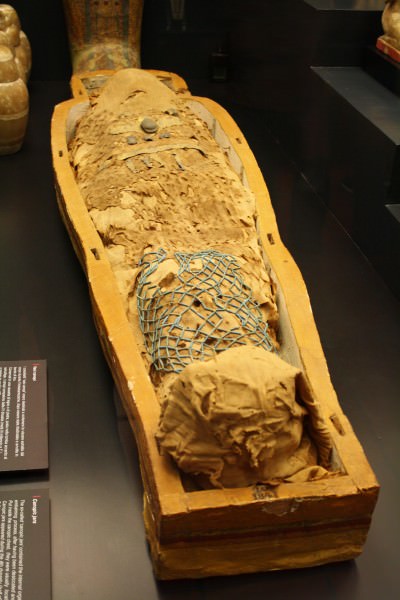
Mummy of Amenirdis
Amenirdis I took control of Thebes and then simply claimed rule of Upper Egypt. The princes of Lower Egypt at this time were engaged in their own conflicts with each other and so Kashta arrived at Thebes and declared himself King of Upper and Lower Egypt. Without raising an army or initiating any kind of conflict with the Egyptians, he founded the 25th Dynasty of Egypt under which the country was ruled by a Kushite monarchy. Kashta did not live long after his success, however, and was succeeded by his son Piye (747-721 BCE).
There is no record of the reaction of the princes of Lower Egypt to Kashta's declaration but they strongly objected to Piye's efforts to consolidate Kushite rule in the country. Piye did not negotiate with those he saw as rebel princes and marched his army north, conquering all the cities of Lower Egypt, and then returned to Napata. He allowed the conquered kings to retain their thrones, re-establish their authority, and continue on as they had previously; they simply had to acknowledge him as their lord. Piye never ruled Egypt from Thebes and does not seem to have given it much thought after his campaign.
Piye's brother, Shabaka (721-707 BCE) succeeded him and continued to reign from Napata. The royalty of Lower Egypt again rebelled, however, and Shabaka defeated them. He established Kushite control firmly throughout Lower Egypt all the way to the Delta region. Early 20th-century CE scholars claim that this was a “dark time” for Egypt when Nubian culture supplanted traditional Egyptian values but this cannot in any way be supported. So-called Nubian culture, by this time, was highly Egyptianized and, further, Shabaka admired Egyptian culture as much as his brother and father had. He continued to observe Egyptian policies and respected Egyptian beliefs. He had his son, Haremakhet, appointed High Priest of Amun at Thebes, effectively making him ruler of Egypt, and embarked on a series of building projects and reconstruction efforts throughout the country. Shabaka, far from destroying Egyptian culture, preserved it.
WITHOUT RAISING AN ARMY OR INITIATING ANY KIND OF CONFLICT, KASHTA FOUNDED THE 25TH DYNASTY OF EGYPT UNDER WHICH THE COUNTRY WAS RULED BY A KUSHITE MONARCHY.
Shabaka's younger brother (or nephew), Shebitku (707-690 BCE) succeeded him and began well until he came into conflict with the Assyrians. The Egyptians had maintained a buffer zone between their northern borders and the region of Mesopotamia which had been lost by this time. Kingdoms such as Judah and Israel had now rebelled against domination by the Assyrians of Mesopotamia and Shabaka had given sanctuary to a rebel leader, Ashdod, who had revolted against the Assyrian king Sargon II (722-705 BCE). The 25th Dynasty continued to support these kingdoms against the Assyrians, and this brought the Assyrian army to Egypt under their king Esarhaddon in 671 BCE.
Esarhaddon met the Kushite king Taharqa (c. 690-671 BCE) in battle, defeated him, captured his family and other Kushite and Egyptian nobles, and had them sent back to Nineveh in chains. Taharqa himself managed to escape and fled to Napata.He was succeeded by Tantamani (c. 669-666 BCE) who continued to antagonize the Assyrians and was defeated by Ashurbanipal who conquered Egypt in 666 BCE.
THE GREAT CITY OF MEROE
The 25th Dynasty ended with Tantamani, and he was replaced by the Assyrians with a puppet king known as Necho I. Necho's son, Psammeticus I (also known as Psamtik I, c. 665-610 BCE), threw off Assyrian rule and founded the 26th Dynasty of Egypt. Psammeticus I and his successor, Necho II, ruled well, but Necho II's successor, Psammeticus II, felt he needed a glorious military campaign in keeping with the great pharaohs of the New Kingdom. He, therefore, led an expedition against Kush, destroying towns, temples, monuments, stele, and finally the city of Napata before he grew bored with the campaign and returned to Egypt.
At this time, c. 590 BCE, the capital of the Kingdom of Kush moved further south to the city of Meroe for safety. The kings of Meroe continued to emulate Egyptian custom and fashion and follow Egyptian policy and religious practice until the reign of the king Arkamani I (also known as Ergamenes, 295-275 BCE). The Priests of Amun had long held power over the Kushite monarchy by allotting each king a certain amount of time to reign, and when their god indicated to them that time was up, the king had to die and another was chosen by the priests.
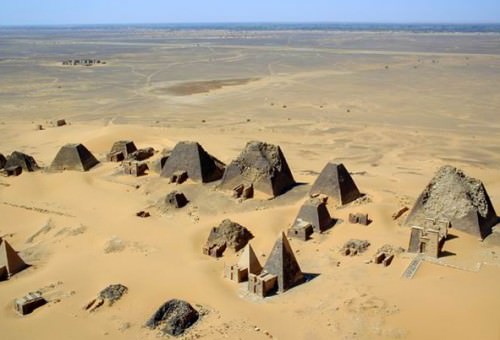
The Pyramids of Meroe
According to the historian Diodorus Siculus (1st century BCE), Arkamani I had been educated in Greek philosophy and refused to be controlled by the superstitions of the priests. He led a band of men to the temple, had all the priests slaughtered, and ended their power over the monarchy. He then instituted new policies and practices which included abandoning Egyptian culture, with an emphasis on Kushite. Arkamani I discarded hieroglyphic script in favor of another known as Meroitic which, to date, has not been deciphered. The fashion of the people of Meroe during his reign shifts away from Egyptian to distinctly Meroitic and the gods of the Egyptians become assimilated into Kushite deities such as Apedemak. The tradition of burying royalty at Napata was also abandoned and kings would thenceforth be entombed at Meroe.
Another interesting innovation of Arkamani I's reign was the establishment of female monarchs at Meroe. These queens, known as Candaces (also Kandake, Kentake) ruled between c. 284 BCE - c. 314 CE. Although they had male escorts in public ceremonies, they were not subject to male domination. The earliest recorded queen is Shanakdakhete (c. 170 BCE) who is shown in full armor leading her troops in battle. The title of Candace is thought to mean “Queen Mother” but exactly what this refers to is unclear. It may have meant “royal woman” or “mother of the king” initially but the queens who held the title appear as monarchs who were not defined by their relationship with men. One of these queens, Amanirenas (c. 40-10 BCE), led her people successfully through the Meroitic War between Kush and Rome (27-22 BCE) and was able to negotiate favorable terms in the peace treaty from Augustus Caesar.
CONCLUSION
Meroe, on the banks of the Nile, was an agricultural and industrial complex, as well as the capital of the Kingdom of Kush, and grew wealthy through its iron works and trade. Grains and cereals were exported along with iron weapons and tools and livestock roamed the fields around the city. Meroe was so wealthy that it became legendary and the Persian king Cambyses II (525-522 BCE) is said to have even launched an expedition to sack it. If said expedition was ever mounted, it never reached the city, and legend claims that Cambyses II's army was defeated by the inhospitable terrain they had to cross and the weather.
Large forests rose on the far side of the fertile fields surrounding the city which were irrigated by canals off the Nile. The upper class lived in large houses and palaces which looked down on broad avenues lined with statuary while the lower classes lived in mud-brick homes or huts. According to ancient inscriptions, even the poorest citizen of Meroe was still better off than anyone elsewhere. The Temple of Amun, in the center of the city, was reportedly its jewel and on par with the earlier temple at Napata.
In c. 330 CE the Axumites invaded and sacked Meroe. Although the city would continue on another 20 years, it was effectively destroyed by the Axumites. Even if the invasion had not come, however, Meroe was doomed and had brought this on itself.The iron industry required massive amounts of wood to create charcoal and fuel the furnaces for the iron resulting in deforestation of the once-plentiful forests. The fields were overgrazed by cattle and overused for crops, depleting the soil.Before the Axumites ever arrived, Meroe must have been in decline and would have had to be abandoned anyway. When the last of the people walked away from the city c. 350 CE, the Kingdom of Kush had come to an end.
Arsacid Dynasty of Armenia › Origins
Definition and Origins
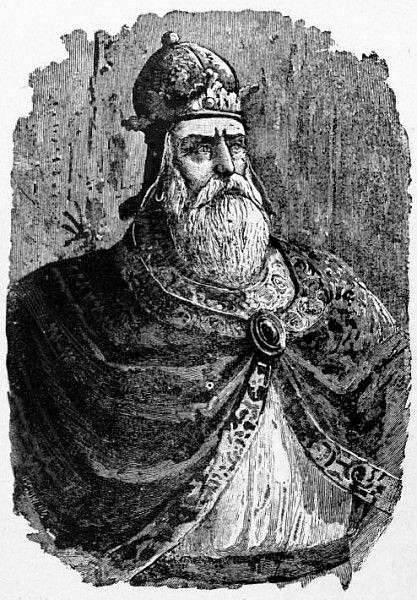
The Arsacid (Arshakuni) dynasty of Armenia ruled that kingdom from 12 CE to 428 CE. A branch of the Arsacid dynasty of Parthia, the Armenian princes also played out a prolonged balancing act by remaining friendly to the other great power of the period and region: Rome. As so often before, Armenia continued to be a hotly disputed territory between Persia and Rome with both sides intervening directly into affairs of state and occasionally sending their armies to back their claims. The period saw great social changes in Armenia, too; notably the official adoption of Christianity in the early 4th century CE and the invention of the Armenian alphabet. The dynasty, as well as the 1000-year-old monarchic system of Armenia, ended with the installation of Persian viceroys in a system which would last until the Arab invasions of the 7th century CE.
The period of history of both Armenia and the region during the reign of the Arsacids was a complex one and the kingdom remained, as it already had been for centuries, a coveted piece in the strategic board game of empires played out by Europeand Asia's two superpowers: Rome and Persia. To add an additional layer of difficulty, the historical record is patchy at best, a situation here starkly summarised by Professor of Armenian and Near Eastern History RG Hovannisian:
Our knowledge of the events or even the chronology of Armenia during this complicated period remains fragmentary in the extreme, confused and still highly debated. (63)
Fortunately, despite these difficulties, a general overview can be acquired by piecing together the works of various Romanauthors, early Christian authors, inscriptions, coinage and archaeology. It must always be born in mind, though, that such questions as who supported who, when and why have answers very often made opaque by missing information and national bias - both ancient and modern.
ROME & PARTHIA
The volatile political reality of Armenia in the second half of the 1st century BCE is reflected in the short reigns and frequent change of monarchs of the ruling Artaxiad (Artashesian) dynasty: nine rulers from 30 BCE to the first decade of the 1st century CE. The decline of the Artaxiads was in part due to the internal factions which had been created by the nobility splitting into either pro-Roman or pro-Parthian factions when the kingdom was caught in regional power politics. In unclear circumstances, the Artaxiads were succeeded by the next dynasty to dominate Armenian affairs, the Arsacid (Arshakuni) dynasty, when their founder, Vonon (Vonones) took the throne in 12 CE with Roman backing. However, the trend of short-reigning monarchs would continue until the arrival of Tiridates (Trad), considered by some to be the real founder of the Arsacid dynasty.

Arsacid Armenia
TIRIDATES I
Tiridates I of Armenia (r. 63 - 75 or 88 CE) was the brother of the Parthian king Vologases I (rc 51-78 CE) who invaded Armenia in 52 CE for the specific purpose of setting Tiridates on the throne. The Romans were not content to let Parthia into what they considered a buffer zone between the two powers and, in 54 CE, Emperor Nero (r. 54-68 CE) sent an army under his best general Gnaeus Domitius Corbulo. Vologases had, by that time, been forced to withdraw to deal with internal troubles in Parthia but Tiridates remained at Artaxata and he was supported by most of the Armenians.
IN 63 CE IT WAS AGREED THAT PARTHIA HAD THE RIGHT TO NOMINATE ARMENIAN KINGS, BUT ROME THE RIGHT TO CROWN THEM.
Corbulo proved to be a very capable field commander and by 60 CE he had taken the two most important Armenian cites - Artaxata and Tigranocerta - and could claim to rule over all of the kingdom of Armenia. Parthia responded by sending an army which won a victory against the Romans (significantly, perhaps, no longer commanded by Corbulo). In 63 CE the Romans and Corbulo returned and their threat was sufficient for the Treaty of Rhandia to be drawn up. It was now agreed that Parthia had the right to nominate Armenian kings, but Rome the right to crown them. Nero was thus given the privilege of crowning Tiridates in Rome in a lavish spectacle that did much to show the power and extent of the Roman Empire. The Romans, just to be on the safe side, then placed a handful of garrisons in the area. Vespasian (r. 69-79 CE) made sure that no more territories would fall to the Parthian ruling dynasty by annexing the neighbouring kingdoms of Commagene and Lesser Armenia in 72 CE. A period of peace followed and Tiridates was able to build a new summer residence at Garni which had the Roman baths, temple and gardens typical of the Classical world.
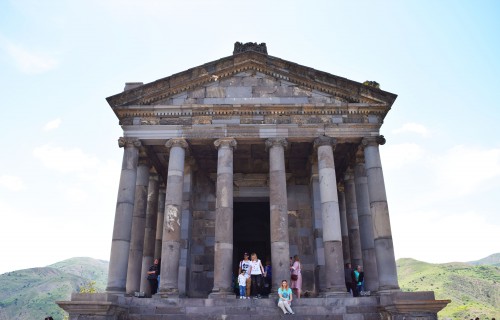
Front View of Garni Temple in Armenia
TRAJAN & ROMAN DOMINANCE
The region erupted again when the sons of Pacorus II of Parthia (r. 78-105 CE), Axidares and Osroes I, squabbled over the Armenian throne with Osroes removing Axidares and making his other brother Parthamasiris the king of Armenia (possible reign 113-115 CE). This caused the already precarious balance of regional politics to be upturned completely when Emperor Trajan (r. 98-117 CE), using the excuse of not being consulted on the change, grabbed the moment and annexed Armenia for Rome. He then declared war on Parthia in 114 CE. Parthamasiris had given in to the Roman emperor when he arrived with his army but Trajan rejected his submission and Armenia was made a province of the Roman Empire and administered alongside Cappadocia.
Poor Parthamasiris was given the honour of a Roman knightly escort to get back to Parthia but was murdered on the way, probably by the knights who were under Trajan's orders. Trajan had taken no chances with the lower sections of the population either and he left two army divisions and built a fort at Artaxata to ensure Armenia stayed a Roman province. Still, when the emperor died in 117 CE rebellions began to spread and his successor Hadrian (r. 117-138 CE), much less enthusiastic about keeping the bothersome province, allowed it to become independent. In reality, this merely gave it up to the Parthians but Armenia would continue to be disputed territory well into the 4th century CE.
ROME & PERSIA AGREED THE CITY OF ARTAXATA WAS TO BECOME ONE OF THE OFFICIAL TRADING POINTS BETWEEN THE TWO EMPIRES.
In 117 CE the new Arsacid ruler Vagharsh I was crowned king of Armenia and he would rule until 140 CE during which time he moved the official royal residence to Vagharshapat while Artaxata remained the capital. Roman oversight did not go away, as is confirmed by Antoninus Pius ' (r. 138-161 CE) selection of Sohaemos as the new king in 140 CE. When the king was deposed in 160 CE Marcus Aurelius (r. 161-169 CE) sent an army to restore the monarch (163 CE) who would then rule until 180 or 185 CE. Relations with Rome were not always so cordial and Artaxata was sacked in 166 CE before both Rome and Persia agreed the city was to become one of the official trading points between the two empires. As a consequence, the city prospered thereafter.
POLITICAL & SOCIAL STRUCTURES
The constant warfare of this period had political repercussions within Armenia during the Arsacid dynasty. There rose a class of landed aristocracy whose ability to raise bodies of armed men to support the royal family meant that they grew in influence - the king needed their armies and could offer land and titles in return. These local princes or nakharars, were based on the hereditary clans of ancient Armenia and they governed their own extensive lands as autonomous fiefdoms. Below these feudal lords, as recorded in the anonymous 5th century CE History of Armenia, were a class of knights, the azats, then the ordinary citizens or ramiks, the peasants or shinakans, and finally the slaves or struks.
The king ruled as an absolute monarch but his reliance on the nakharars did mean in practice he had to at least to consult them on important matters of policy. The general populace was governed by local administrators controlled by several government ministries which were responsible for such essentials as tax collection, justice, and public works projects like the building of roads, fortresses and irrigation systems. It has been argued that the constant invasions and the testing of nakhararloyalties, along with the general necessity to all pull together or be conquered, helped build a national spirit and that, for the first time, ancient Armenia began to feel and act like a unified country.
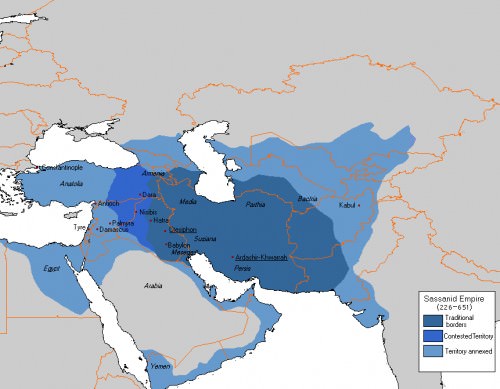
Territorial Expansion of the Sasanian Empire
SASANIAN EMPIRE
In 224 CE the Arsacid dynasty in Parthia was overthrown by Ardasir (aka Artashir Papakan), founder of the Sasanid dynasty which would rule until 651 CE. The change marked a more aggressive foreign policy from Persia regarding Armenia which culminated in a full-scale invasion by the Sasanids in 252 CE. The Armenian Arsacid kings, with such close blood ties to the vanquished Arsacids in Persia, posed a threat of legitimacy to the new Sasanid order. The Sasanids won several major victories against Rome in this period, including the capture of Emperor Valerian (r. 253-260 CE) which ended his reign. Rome came back strongly, though, from the reign of Aurelian (270-275 CE) after a period of chaotic rule and several short-reigning emperors preoccupied the Romans with internal affairs. When the dust finally settled again the kingdom of Armenia found itself divided up between Rome and Persia with the Arsacids continuing to rule only western Armenia. In 298 CE, under the auspices of Diocletian (r. 284-305 CE), Armenia was unified with Tiridates IV (Trdat IV) as king (rc 298 - c. 330 CE) - one of the great rulers of the Arsacid dynasty.
TIRIDATES THE GREAT
Tiridates IV (or III), or Tiridates the Great as he would become known, set about centralising his kingdom and reorganising the provinces and their governors. Land surveys were also carried out to better identify tax obligations; the king was determined to make Armenia great once again and regain some of the lost glitter not seen since the days of Tigranes the Great in the first half of the 1st century BCE.
TRADITION RECORDS THAT TIRIDATES IV WAS CONVERTED TO CHRISTIANITY IN 301 CE BY SAINT GREGORY THE ILLUMINATOR.
Then came a momentous policy change. Armenia officially adopted Christianity c. 314 CE, if not earlier, as tradition records that Tiridates IV was converted in 301 CE by Saint Gregory the Illuminator. Although it shifted Armenia closer to Roman religious culture, one consequence of the move was that the persecution of the religion by Persia helped to create a more fiercely independent state. Saint Gregory, then known as Grigor Lusavorich, was made the first bishop of Armenia in 314 CE.Tiridates IV may also have adopted Christianity for internal political reasons - the end of the pagan religion (with its heady mix of Greek, Persian, Semitic and local gods) was a fine excuse to confiscate the old temple treasuries which were jealously guarded by a hereditary class of priests. Further, a monotheistic religion with the monarch as God's representative on earth might well instill greater loyalties from his nobles and people in general.
In the 330s CE, Tiridates' successor, Khosrov III (rc 330-338 CE), notably founded the city of Dvin. In the same period the Sasanids again became more ambitious to rule directly over Armenia, especially during the reign of the Sasanid king Shapur III (r. 383-388 CE). The Sasanids first deposed Tiran in 338 CE and then Arshak II in 350 CE (reign dates for both are disputed). Several Armenian cities were attacked by Sasanid forces in 368 and 369 CE and the matter of who would rule Armenia was only to be resolved in c. 387 CE. It was then that emperor Theodosius I (r. 379-395 CE) and Shapur III agreed to formally divide Armenia between the Eastern Roman (Byzantine) Empire and Sassanid Persia.
FALL OF THE ARSACIDS
During the reign of the last great Arsacid monarch, Vramshapuh (r. 389 or 401 - 415 or 417 CE) there were significant cultural developments in Armenia. In 405 CE the Armenian alphabet was invented by Mesrop Mashtots and the Bible translated into that language, helping to further spread and entrench Christianity in Armenia. Politically, though, it was time for a change. The last Arsacid ruler was Artashes IV (r. 422-428 CE) after the Armenian crown, unable to repress the pro-Persian and anti-Christian factions at court, was abolished by Persia and viceroy rulers, the marzpans, were installed, in a situation which would not change until the mid-7th century CE.
This article was made possible with generous support from the National Association for Armenian Studies and Researchand the Knights of Vartan Fund for Armenian Studies.
LICENSE
Article based on information obtained from these sources:with permission from the Website Ancient History Encyclopedia
Content is available under License Creative Commons: Attribution-NonCommercial-ShareAlike 3.0 Unported. CC-BY-NC-SA License
